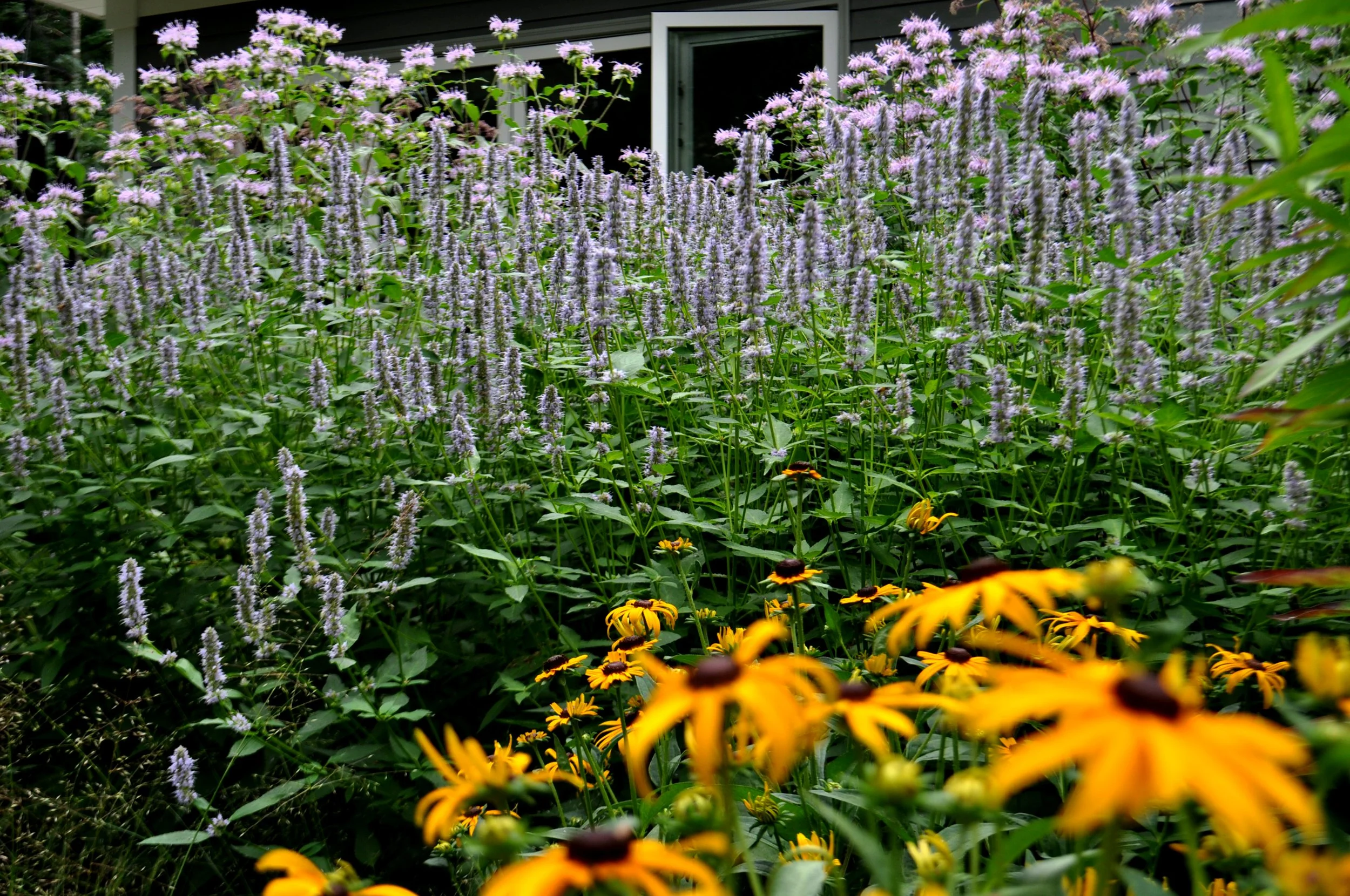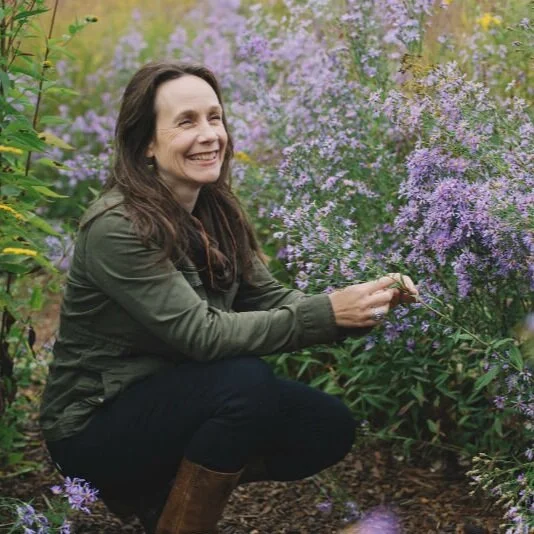Updated March 24, 2025
“If you fail to plan, you are planning to fail.”
Around this time of year, a lot of us are getting tired of Old Man Winter and are looking forward to the first blooms of spring.
Good news! We have less than one month left of meteorological winter (which runs from December 1st through the end of February).
That means we are actually two-thirds of the way through the coldest 3-month season of the year! The days are noticeably longer and on some sunny afternoons you can catch a hint of spring in the air.
With the promise of spring, let’s start planning! This is the perfect time to plan for the gardening season in Maine. I bet you’re already scheming and daydreaming about what you’ll grow this year.
Have you been thinking about creating a more intentional space for wildlife, but you’re not sure where to start?
I’m here to tell you that you just need to start somewhere, and the best time to start is now. I'm also here to help! So make yourself a cup of hot coffee or tea, and grab a pen and paper. Set some goals and make some notes. A little planning now will go a long way to help you achieve your overall vision (which will take persistent, consistent action over many years).
This is also the perfect time to book me for a landscape consultation - before my busy season is in full swing. By booking now, you’ll make sure to reserve your spot for a spring or summer consultation.
Wouldn’t it feel great to take that next step – to begin crafting your habitat vision at home with my personalized attention and custom recommendations?
Why Now?
Let’s review a few of the reasons we should plan our gardens now (in February).
Planning ahead gives you plenty of time to source your seeds and plants.
The seed catalogs are hot off the presses and inventory is stocked.
We have about 3 to 4 months until our last spring frost date, giving you time to order and plant any seeds you want to start indoors.
Annual plant sales have been scheduled for the year, and you’ll have ample time to think about what you want to purchase.
The best plants for wildlife are not always easy to find. If you think ahead, you’ll have time to shop around, and even custom order something from a seed company or nursery. Read on for more about plant sources (see #5, below).
Make a Plan to Create Habitat - Right Where You Are
My definition of a habitat garden is: an intentional, cultivated space designed to benefit wildlife.
1. Plant natives.
Plants are the basis for habitat because they support insect populations, which in turn support all other higher forms of life in our yards, and beyond. Most insects can only use plants that they co-evolved with (i.e., native plants). If your goal is to support wildlife and conserve biodiversity – native plants are the way to go.
Many nurseries stock “cultivars” or “nativars” which are so-called natives that have been bred to have day-glow foliage, double flower heads, disease resistance, or other selected traits. A clue that you are looking at one of these artificially selected plants are names like “Razzmatazz” or “Pink Double Delight.” Double flowers often make it difficult for bees and butterflies to gather pollen and nectar. Some nativar blooms are sterile, too, which means no seeds for birds, and no self-sowing in the garden. Responsible non-native plants (that are not invasive) may have their place in your landscape as well (especially the annuals listed below, see #4).
A great way to get around this is to sow wild-type seeds yourself. Many native species are grown from seed that is sown outdoors in pots from November through February. To learn more, see The Wild Seed Project.
If you want to attract birds, bees, butterflies, and boost overall biodiversity: you must cultivate a landscape rich in native plants because they support a diversity of native insects, the basis of the food web.
2. Plant native woody plants.
Woody plants capture more carbon than herbaceous plants and are key to building climate resilience. These plants also provide wildlife with year-round protection from the elements, while modulating severe weather around our homes by blocking winter winds, and providing shade and cooling services in summer. The extensive root systems of woody plants also stabilize soil, filter runoff, and provide other important ecosystem functions.
Shrubs are workhorses in the habitat garden. They quickly provide abundant flowers, fruits, and cover for wildlife. Although they may start small, many species are fast growing and their benefits quickly multiply. Aesthetically, even just a single shrub provides interesting structure and depth in your landscape. Great choices include native blueberry (Vaccinnium corymbosum and/or V. angustifolium), native dogwoods (Cornus/Swida spp.), and native viburnums (Viburnum spp. including V. lentago, V. nudum, V. prunifolium, and V. acerifolium).
Trees offer the services described for shrubs above, but on a grander scale. They are also key to building habitat structure and diversity, particularly with regards to their role at the crown of layered native plant communities. Many of our most common native trees (such as oak, birch, maple, and pine) are keystone plants, which means they are particularly foundational to a healthy, biodiverse food web. Want a list of the top keystone plants for Maine? Request it here.
3. Plant native herbaceous perennials.
There are so many beautiful native perennials to choose from that will benefit native bees, butterflies, moths, and hummingbirds. Asters, coneflowers, milkweeds, and bee balm are excellent choices. Make sure to include native grasses, sedges, and groundcovers in your gardens, as well.
I invite you to attend one of my upcoming programs or work with me to learn more about planting for wildlife.
4. Plant Annuals that Attract Beneficial Insects
Beneficial insects are key to garden health and ecosystem function, and are essential to successful organic gardening methods. They control garden pest populations, pollinate our crops, and much more. Mary Gardiner, author of Good Garden Bugs, recommends a list she calls “The Sweet Seven”:
Dill (Anethum graveolens)
Coriander/Cilantro (Coriandrum sativum)
Buckwheat (Fagopyrum esculentum),
Sweet Alyssum (Lobularia maritima)
Fava Beans (Vicia faba),
Phacelia (Phacelia tanacetifolia)
Borage (Borago officinalis)
Want to learn more? Listen to Margaret Roach’s great interview with Mary Gardiner.
In addition to these “Sweet Seven” annuals, I recommend:
Fennel (Foeniculum vulgare)
Scarlet Runner Bean (Phaseolus coccineus)
Mexican Sunflower (Tithonia rotundifolia)
Nasturtium (Tropaeolum spp.)
Calendula (Calendula officinalis)
5. Support local nurseries, native plant sales, and native plant growers. As you plan your habitat, you might need some help finding places to source native plants. Request a copy of my custom-curated list of plant sources for northern New England here.
A little planning ahead, calling around, and some thoughtful research will allow you time to source the best native plants for wildlife.
Did you know? We have converted over 40 million acres of wildlife habitat to lawn in the United States. That’s an area equal to eight times the size of New Jersey! Lawns are comprised of nothing but very short, non-native grasses with no cover or food for wildlife. Replace areas of your lawn with habitat gardens, meadowscapes, and more — you’ll be restoring critical habitat and boosting biodiversity for a more resilient and thriving future for all. Be part of the movement - get on the map of the Homegrown National Park.
SIGN UP TO RECEIVE FREE TIPS, TOOLS, AND INSIGHTS FOR BUILDING HABITAT AND HOPE.
#ThePersonalEcologist
I partner with eco-minded landowners to create thriving wildlife habitats in their backyards, gardens, fields and farms, woods or campuses - at any scale.
I have 25 years of experience in my field, and a lifelong commitment to wildlife conservation.
Read My Story.
-
Deborah
Perkins
- Oct 31, 2025 Hallowed Habitat
- Dec 22, 2023 Storm Habitat: Nurse Logs, Dens, and More
- Aug 8, 2023 Beautiful Buttonbush in Bloom
- Jun 17, 2023 Snapping Turtles on the Move
- Feb 1, 2023 The True Harbingers of Spring: Chickadees
- Mar 20, 2021 The Power of Photoperiod
- Feb 19, 2021 The Golden-crowned Kinglet: A Royally Charming Winter Resident
- Feb 8, 2021 Subnivean Secrets
- Jan 9, 2021 Wild Reads: Ravens in Winter
- Oct 23, 2020 Flower “Beds” for Bumble Bees
- Oct 4, 2020 Wise Oaks, Clever Jays
- Sep 11, 2020 Goldenrods: Top Plants for Boosting Biodiversity
- Aug 25, 2020 Gentle Golden Wasps Adorned with Pollen
- Aug 1, 2020 Water for Wildlife - Birdbath Basics & More
- Jul 19, 2020 Fruits of the Forest
- Jul 11, 2020 Hungry Little Hummingbirds
- Jun 24, 2020 Hatching Out: Mother Nature's "Escape Room"
- Jun 12, 2020 Maine's Real Lupine Revealed
- May 31, 2020 Wild Geranium in Flower
- May 24, 2020 Moosewood Chandeliers
- May 17, 2020 Shadbush in Bloom
- May 7, 2020 Native Nectar for Queen Bumble Bees
- Apr 25, 2020 Waves of Warblers
- Apr 19, 2020 Attracting Bluebirds without Boxes
- Apr 12, 2020 Hungry Bears on the Move
- Apr 5, 2020 Bees on Red Maple Flowers
- Mar 27, 2020 Sky Dancing
- Mar 22, 2020 Fox Kits Being Born
- Mar 15, 2020 Corvids a-Courtin’
- Mar 8, 2020 Phenology Notes: Witnessing The Seasons of our Wild World
- Feb 5, 2019 Plan Your Habitat Garden
- Jan 2, 2019 Wild Reads: We Took to The Woods
- Nov 28, 2018 Winterberry: The Gift that Keeps on Giving
- Aug 16, 2018 Where Have All the Whip-poor-wills Gone?
- Jun 22, 2018 Give a Warm Welcome to Wild Bees (Super-pollinators Part 2)
- May 16, 2018 The Wonder of Wild Bees (Super-pollinators Part 1)
- Apr 19, 2018 Saving Songbirds Starts with Your Morning Coffee
- Mar 21, 2018 Wildlife Habitat Design in A Wounded World
- Feb 16, 2018 “Intelligent Tinkering” - How to Boost Biodiversity at Home (Leopold’s Wise Words Part 2)
- Jan 18, 2018 Carnivore Coexistence (Leopold's Wise Words - Part 1)
- Dec 14, 2017 Dead and Dying Trees are Key to Life
- Nov 14, 2017 A Top Threat to Biodiversity: Invasive Plants
- Sep 21, 2017 Beechnuts - Superfood for Bears & Other Wildlife
- Aug 22, 2017 Baby Bats Need Love Too
- Jul 25, 2017 Bring the Magic of Fireflies Back Home Again





